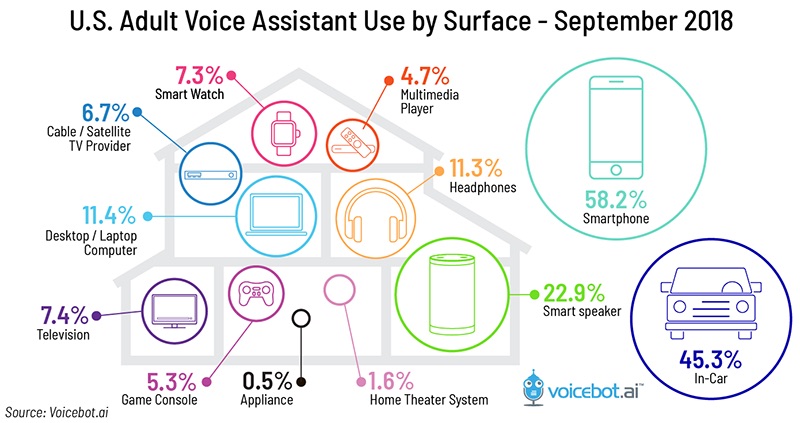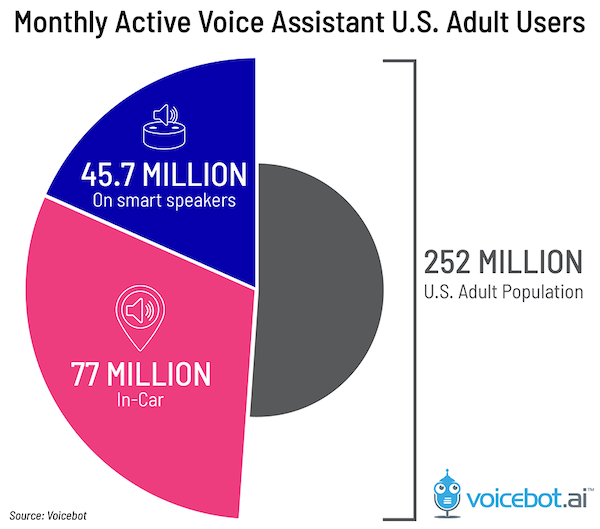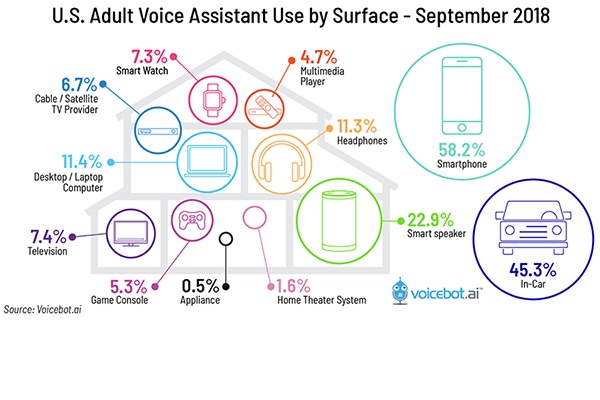Twice the Number of U.S. Adults Have Tried In-Car Voice Assistants as Smart Speakers
Smart speakers and other devices with embedded voice assistants get a lot of media coverage, but twice as many U.S. adults have used voice in the car and monthly active users are 60% higher. Voicebot collaborated with Drivetime.fm and Voice of the Car Summit in analyzing data from a survey of 1,040 U.S. adults to better understand usage and attitudes toward voice assistant use in the car. What we found was the car is firmly established as one of the big three voice assistant access points along with smartphones and smart speakers.

Download Report
Why Voice is Bigger in the Car
The key reasons why voice assistant use is bigger in the car today than smart speakers is that it has been around longer and there are more car owners than smart speaker owners. The first production in-car voice assistant was introduced a decade before the Amazon Echo and nearly 90% of U.S. adults have a car whereas only about 23% own a smart speaker. In addition, the use cases for in-car voice assistants are well aligned with the environment: the driver’s hands and eyes are occupied. Whereas voice use in the home may offer heightened convenience, users tend to be freer to use screens to navigate digital interactions. Niko Vuori, CEO and founder of Drivetime.fm, commented about the importance of voice interaction in the car:
It’s no surprise that voice is already used by more people in the car than in the home – after all, the car is the most natural environment for voice interaction given that your hands should be on the wheel and your eyes should be on the road.
Survey data show that 114 million U.S. adults have tried voice assistants in the car and 77 million have made it a monthly habit. That is a 67.5% conversion rate to monthly use. It also represents about 60% more monthly active users than the 45.7 million regular users of voice assistants through smart speakers.

The data show that voice assistants and the car are a natural match of form and function. Bradley Metrock, founder of Score Publishing and host of the Voice of the Car Summit, commented:
“The very first speaker we booked, for the very first Alexa Conference two years ago, was in the transportation sector, speaking about how voice assistants would be able to reduce driver reliance on distracting screens while navigating. Since then, the need for this technology to become ubiquitous is more and more obvious. 2019 appears to be the year we take a big step in this direction.”
The Most Comprehensive Study to Date of Voice Assistant Use in the Car
The data above comes from the newly published In-Car Voice Assistant Consumer Adoption Report. It is a 33-page report with 17 charts and diagrams based around a national survey of U.S. adults and an analysis of activity by leading automakers, device makers, and voice assistant platforms. Automakers covered in the report include BMW, Chevrolet, Ford, Hyundai, Mercedes, and Toyota. Other companies that support voice assistant use in the car covered in the analysis are Amazon, Apple, Google, Nuance, SoundHound, Anker, and more. The report answers questions such as:
- What are the most common use cases for voice assistant use in the car?
- How do consumers view voice assistants today and do they expect to increase or decrease usage in the future?
- How do age and income demographics impact in-car voice assistant usage?
- What voice assistant providers focus on the car and what services do they offer?
- What devices are bringing voice assistants into the car without the need for infotainment integration?
- What are leading car companies doing today about voice assistant access in the car?
Follow @bretkinsella Follow @voicebotai
Drivetime Closes $4 Million Seed Round, Launches Voice Trivia Game for Commuters









